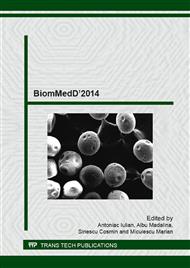[1]
S.J. Sadowsky, Treatment considerations for maxillary implant overdentures: a systematic review. J. Prosthet. Dent. , 97 (2007), p.340–348.
DOI: 10.1016/s0022-3913(07)60022-5
Google Scholar
[2]
I. Naert, G. Koutsikakis, J. Duyck, M. Quirynen, R. Jacobs, D. van Steenberghe, Biologic outcome of implant-supported restorations in the treatment of partial edentulism, Clinical Oral Implants Research 13(2002), p.381–389.
DOI: 10.1034/j.1600-0501.2002.130406.x
Google Scholar
[3]
S. Ghodisi, S. Rasaeipour, Tooth-implant connection: a literature review, World Journal of Dentistry, Vol. 3, Iss. 2 (2012), pp.213-219.
DOI: 10.5005/jp-journals-10015-1159
Google Scholar
[4]
B. Engquist, T. Bergendal, T. Kallus, U. Linden, A retrospective multicenter evaluation of osseointegrated implants supporting overdenture. International Journal of Oral Maxilofacial Implants, vol. 3, no. 2 (1988), p.129–134.
Google Scholar
[5]
T. Jemt, J. Chai, J. Harnett, M.R. Heath, J.E. Hutton, R.B. Johns, S. McKenna D.C. McNamara, D. van Steenberghe, R. Taylor, R.M. Watson, I. Herrmann, A 5-Year prospective multicenter follow-up report on overdenture supported by osseointegrated implants. Int J Oral Maxilofac Implants, 11 (1996).
DOI: 10.1034/j.1600-0501.1996.070405.x
Google Scholar
[6]
D.M. Brunette, P. Tengvall, M. Textor, P. Thomsen, Titanium in medicine: material science, surface science, engineering, biological responses, and medical applications, Ed. Springer, Berlin, Germany, (2001).
DOI: 10.1007/978-3-642-56486-4
Google Scholar
[7]
H.U. Hherbert, R.W. Revie, Corrosion and corrosion control, Ed. Jhon Willey & Sons, New York, 1985: 1.
Google Scholar
[8]
J. Geis-Gestorfer, H. Weber, Corrosion resistance of the implant materials Contimet 35, Memory, and Vitallium in artificial physiological fluids, Journal for Oral Maxillofac Implants, 3 (1988), pp.135-140.
Google Scholar
[9]
N. Ibris, J.C. Mirza-Rosca, EIS study of Ti and its alloys in biological media, Journal of Electroanalytical Chemistry, Vol. 526, No. 1-2 (2002), pp.53-62.
DOI: 10.1016/s0022-0728(02)00814-8
Google Scholar
[10]
A.K. Shukla, R. Balasubramaniam, S. Bhargava, Properties of passive film formed on CP titanium, Ti-6Al-4V and Ti-13. 4Al-29Nb alloys in simulated human body conditions, Intermetallics, Vol 13, No. 6 (2005), pp.631-637.
DOI: 10.1016/j.intermet.2004.10.001
Google Scholar
[11]
American Society for Metals Handbook. Corrosion, Materials Park: ASM International, (1993).
Google Scholar
[12]
L. Reclaru, J.M. Meyer, Effects of fluorides on Titanium and other dental alloys in dentistry, Biomaterials. 1998; 19(1-3): 85-92.
DOI: 10.1016/s0142-9612(97)00179-8
Google Scholar
[13]
L.A. Rocha, F. Oliveira, H.V. Cruz, C. Sukotjo, M.T. Mathew, Part III: Bio-tribocorrosion in the clinical environment, 10 - Bio-tribocorrosion in dental applications, Bio-Tribocorrosion in Biomaterials and Medical Implants, A volume in Woodhead Publishing Series in Biomaterials, Edited by:Y. Yan, 2013, p.223.
DOI: 10.1533/9780857098603.3.223
Google Scholar
[14]
R. Strietzel, A. Hösch, H. Kalbfleisch, D. Buch, In vitro corrosion of titanium, Biomaterials, Vol. 19, Iss. 16 (1998), p.1495–1499.
DOI: 10.1016/s0142-9612(98)00065-9
Google Scholar
[15]
S.W. Dean Jr., W.D. France Jr., S.J. Ketcham, Electrochemical Methods, Handbook on Corrosion Testing and Evaluation, W. H. Ailor (ed), J. Wiley, New York, New York, pp.171-215, (1971).
Google Scholar


